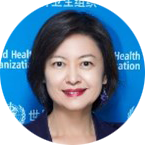Speaker and Presentation Summary
Session 1: Global Perspective of Tobacco Control

Dr YIN Xi
Coordinator, Tobacco Free Initiative, Division of Healthy Environments and Populations, World Health Organization Regional Office for the Western Pacific
Biography
Ms Xi Yin is Coordinator, Tobacco Free Initiative at the World Health Organization’s Western Pacific Regional Office. She coordinates the region’s tobacco control efforts aimed at reducing tobacco use and addressing emerging challenges in tobacco control. Before her current post, she served as the acting lead of the non-communicable disease team of the China Representative Office of WHO, promoting evidence-based interventions and strategies to address NCDs and their risk factors, with tobacco use being the focus.
Prior to joining the World Health Organization in 2019, Ms Yin worked at the Campaign for Tobacco-Free Kids/Global Health Advocacy Incubator, a global public health and tobacco control advocacy organization. During her 12-year tenure, she led efforts in formulating and implementing advocacy strategies and programs to promote public health policies in East Asia and the Pacific. In China, Indonesia, the Philippines and other countries, Ms Yin Xi and her colleagues had worked closely with governments, non-governmental organizations, and academic institutions to promote the adoption and implementation of tobacco control measures. She has organized health policy advocacy training in many countries. She has also provided technical support for government and non-governmental organizations in communications strategies in China, Vietnam, Indonesia, the Philippines, Kenya, Zambia, among others. Ms Yin has carried out dozens of media trainings in countries to improve the media’s capacity in covering health policy issues.
Presentation Summary: Accelerating progress in tobacco control: A regional perspective
Significant efforts have been made at national, regional, and global levels to reduce tobacco use. The latest WHO report shows that tobacco smoking in the Western Pacific Region is declining; but the progress not sufficient to meet the voluntary target of 30% relative reduction in the prevalence of current tobacco use among adults before 2025. Only 6 out of 27 countries in the Western Pacific Region are on track to meet the target. To reverse the tobacco epidemic, countries need to accelerate the implementation of evidence-based tobacco control measures prescribed in WHO FCTC and highlighted in WHO’s MPOWER technical package. Without further actions, the Western Pacific Region is projected to have 6 million more tobacco users by 2025 than there were in 2015.
While tobacco dependence treatment (O) is the least implemented measure in the world, raising tobacco taxes (R) is the least implemented measure in the Western Pacific Region. Globally, 40 countries have achieved the R measure at the highest level, while in the Western Pacific Region, only one country has done so. Overall, no country in the Region has yet managed to reach the highest level for all six MPOWER measures. The region has seen tremendous progress in the adoption of pictorial (or plain) warning labels (W) and monitoring tobacco use and prevention policies (M), but progress in other MPOWER measures has been slow.
To support countries in facilitating the implementation of MPOWER and WHO FCTC, WHO Regional Office for the Western Pacific has developed the Regional Action Plan for Tobacco Control in the Western Pacific (2020-2030), which was endorsed by Member States in 2019. This ten-year roadmap aims to highlight strategic actions for countries and areas to protect people from tobacco and related products, including ENDS and HTPs.
It requires commitment and leadership to tackle the persistent and new challenges to tobacco control. Hong Kong SAR has made great strides in the fight against tobacco and its recent decision to ban the advertisement, import, manufacture, sale and distribution of electronic cigarettes and heated tobacco products demonstrated the Government’s commitment to protecting public health and safeguarding the hard-won progress of tobacco control. Hong Kong SAR can share experiences and lessons learned in combating tobacco use with other countries and areas in the region.

Prof Judith MACKAY
OBE, SBS, JP, FRCP (Edin), FRCP (Lon)
Director, Asian Consultancy on Tobacco Control;
Senior Policy Advisor, World Health Organization;
Special Advisor, Global Centre for Good Governance in Tobacco Control
Biography
Judith MACKAY is a British medical doctor, living in Hong Kong since 1967, initially working as a hospital physician, then since 1984 concentrating on public health, especially tobacco control.
She has published over 250 papers and addressed 600 conferences on tobacco control. Her particular interests are tobacco and women, tobacco control in low and middle-income countries, new tobacco products, and challenging the tobacco industry.
She is author or co-author of a dozen health atlases – portraying global health statistics in a colourful, graphic format - on health, sex, tobacco, cardiovascular disease, cancer, oral health, and Global Adult Tobacco Surveys. These have been translated into many languages.
She is an Honorary Professor in the School of Public Health, University of Hong Kong, and the Chinese University of Hong Kong. She has received honorary degrees from the University of Edinburgh and Shue Yan University in Hong Kong. She is an Honorary Fellow of the Hong Kong College of Cardiology, and the Hong Kong College of Community Medicine.
In addition to many international and national awards ranging from the WHO Commemorative Medal and the TIME 100 World’s Most Influential People Award to the BMJ Group’s first Lifetime Achievement Award, she has been identified by the tobacco industry as one of the three most dangerous people in the world.
Presentation Summary: Overview on tobacco control and endgame, challenges and interference of tobacco industry
Tobacco control has achieved many successes over the last 60 years. There have been enormous improvements in monitoring the epidemic, the creation of smoke-free areas, pack warnings, assistance with cessation, taxation policies, and bans on tobacco advertising, promotion and sponsorship.
The prevalence of smoking has fallen in most countries and even fallen to single digits in places like Hong Kong. Female prevalence rates have remained low in Asia. A few governments have announced an Endgame target of 5% prevalence rates. All WHO member states are aspiring to individual WHO/SDG targets by 2025. But there is no quick fix. Funding for tobacco control remains woefully low at country level, and also for WHO and the WHO FCTC.
The challenges include the focus of the medical profession on curative medicine; health funding going predominantly to hospitals and clinics not to prevention; the reluctance of the health profession to get involved with fighting the tobacco industry; little training in working with the media; and unfamiliarity with the action needed to reduce this epidemic, tobacco tax issues, trade treaties or tobacco smuggling. Obstacles for governments include preoccupation with general issues (such as war or environmental disasters) or other health problems (such as COVID); misperceived economic concerns; lack of understanding of the importance of fiscal measures to reduce the epidemic; lack of political will; and interference by the tobacco industry.
Tobacco control will never be successful unless the vector – the tobacco industry – is exposed and curtailed. While NGOs and academia can research and expose the industry, such as the regular Tobacco Industry Interference Indexes, it is the governments which are ultimately responsible for curtailing unhealthy industries and their influence on public health policy.

Prof Joanna COHEN
Director, Institute for Global Tobacco Control;
Bloomberg Professor of Disease Prevention, John Hopkins Bloomberg School of Public Health, USA
Biography
Joanna Cohen, PhD, Bloomberg Professor of Disease Prevention and Director of the Institute for Global Tobacco Control at the Johns Hopkins Bloomberg School of Public Health, has been involved in tobacco policy research for over 25 years. Trained in epidemiology and health policy, her research focuses on factors that affect the adoption and implementation of public health policies and on evaluating their beneficial effects and the unintended consequences. Dr Cohen is Deputy Editor of the journal Tobacco Control.
Presentation Summary: Measures to reduce attractiveness and addictiveness of tobacco products
Tobacco products are deadly, but they are carefully designed to be addictive, attractive, and appealing. We know most about nicotine’s addictive properties, and there are additional components of tobacco products that contribute to addiction. Compounds such as menthol heighten the impact of nicotine’s addictive qualities, and also make products more palatable to consume. Flavour chemicals are added to tobacco products to increase the appeal of these products, particularly among youth. The packaging and marketing of tobacco products further impact their attractiveness to consumers and potential consumers.
The good news is that countries and other jurisdictions are taking action to address these aspects of tobacco products that are aimed at growing and maintaining the tobacco product customer base. At least two countries are actively considering a requirement to greatly reduce the nicotine content of cigarettes, and a number of countries have already set limits on the nicotine content of e-cigarette liquids. A handful of countries have banned flavours in tobacco products, with some including menthol in their restrictions. Countries have also implemented plain and standardized packaging to reduce the marketing role of the package.
But the tobacco industry does not sit still. Companies work hard to prevent or delay strong tobacco control policies, and, if these policies do get enacted, the companies exploit any loopholes in the legislation and/or regulations.
This presentation will describe the measures that countries have taken to reduce the attractiveness and addictiveness of tobacco products, as well as counter-actions taken by tobacco companies to reduce the public health impact of these measures.
